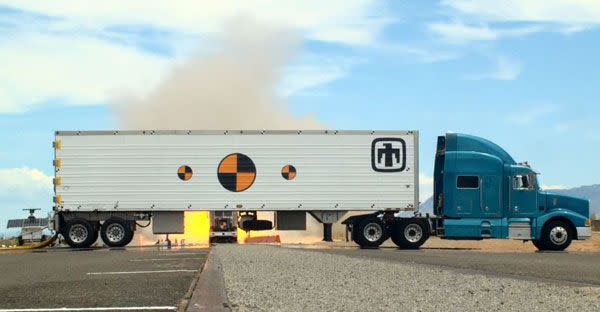A Semi Truck Crashed Into a U.S. Nuclear Weapons Transporter

Engineers have crash tested the next-generation nuclear transport vehicle.
The government says this transport system is key to nuclear weapons deterrence.
A regular truck propelled by a rocket crashed into the prototype truck at full speed.
Nuclear materials must be transported safely, and that has to include road vehicles for at least the very end of these long trips. That's why engineers recently tested a new model of the Mobile Guardian Transporter, the U.S. government’s secure overland option. And so far, they're pleased with the results.
The crash test is simple and dramatic: A prototype of the new Mobile Guardian Transport truck is positioned like a silent movie heroine on the railroad tracks. Then, a regular tractor-trailer is literally rocketed toward it at highway speeds, causing a collision that represents one of the worst-case scenarios of the special truck’s “regular life” driving on public roads. Armor components and other more militaristic technologies have their own testing infrastructure, leaving just regular civilians driving recklessly or in adverse conditions as the X factors.
The crash action takes place at the unfathomably cool-sounding Rocket Sled Track at Sandia National Laboratory. The details, per Sandia's site:
“The Rocket Sled Track provides a controlled environment for high-velocity impact, aerodynamic, acceleration, and other related testing for both small and large test items. The facility provides a 10,000-foot track for testing items at very high speeds, and a 2,000-foot railroad gauge track for testing very large, heavy items at moderate speeds.”
Using the rocket sled track takes months of planning, Sandia says in a statement, while the test itself lasts just seconds. It’s critical to the National Nuclear Safety Administration’s (NNSA) Office of Secure Transportation, for whom human threats like attacks and car crashes must be considered alongside technological or even natural threats.

“Cargo is transported in highly modified secure tractor-trailers and escorted by armed Federal agents in other vehicles who provide security and national incident command system response in the event of emergencies,” the NNSA explains on their site.
The armored and modified trucks are similar to, say, the Secret Service fleet that carries the president: they look like “normal” production vehicles, but are outfitted with the latest, most robust safety structures. Sandia explains:
“Nearly everything that makes up the transporters is custom designed and built, with a few exceptions. Following the 13-month trailer build, the team worked for an additional six months assembling electronics before they began testing the prototype in normal and abnormal environments.”
Today, that advanced technology includes the testing itself. For the new third-generation nuclear trucks, NNSA recently trotted out its first total crash test on this scale in 20 years. The current fleet has been in use since the 1990s, which, at least for consumer vehicles, is before almost all the major safety features of today.
The point of secure transport isn’t the same as consumer safety, but it’s easy to imagine the equivalent jumps forward in technology.
In the most recent test, teams in masks took turns inside the confinement of the vehicle to stay as safe as possible, even during the hot desert summer.
“The prototype was moved to the test site in June, where employees continued preparing for the crash in pandemic conditions, in the heat of the desert—running cables, fixing problems, soldering wires, setting up cameras, checking acquisitions systems and setting triggers,” Sandia explains. “During the test, more than 400 channels of data and video, including high-speed video, were collected.”
And how'd the test go?
On test day, final preparation started several hours before dawn. Around midday, the test execution team, transporter team members and stakeholders stood at a safe distance from the sled track and watched the crash take place. There was a lot of buildup to that point, Jim [Redmond, Sandia's senior manager over the nuclear deterrence program] said, with the years-long effort resulting in a transporter assembly test that was over in a matter of seconds.
“I was glad to see the rockets fired; I was glad to see it was successful,” he said. “It was tense. The entire team, including partners from LANL and Lawrence Livermore, were excited and relieved. There’s a lot of pride among the team, as well as the government sponsors, that we are greatly increasing our understanding of accident environments.”
Watch This:
You Might Also Like

